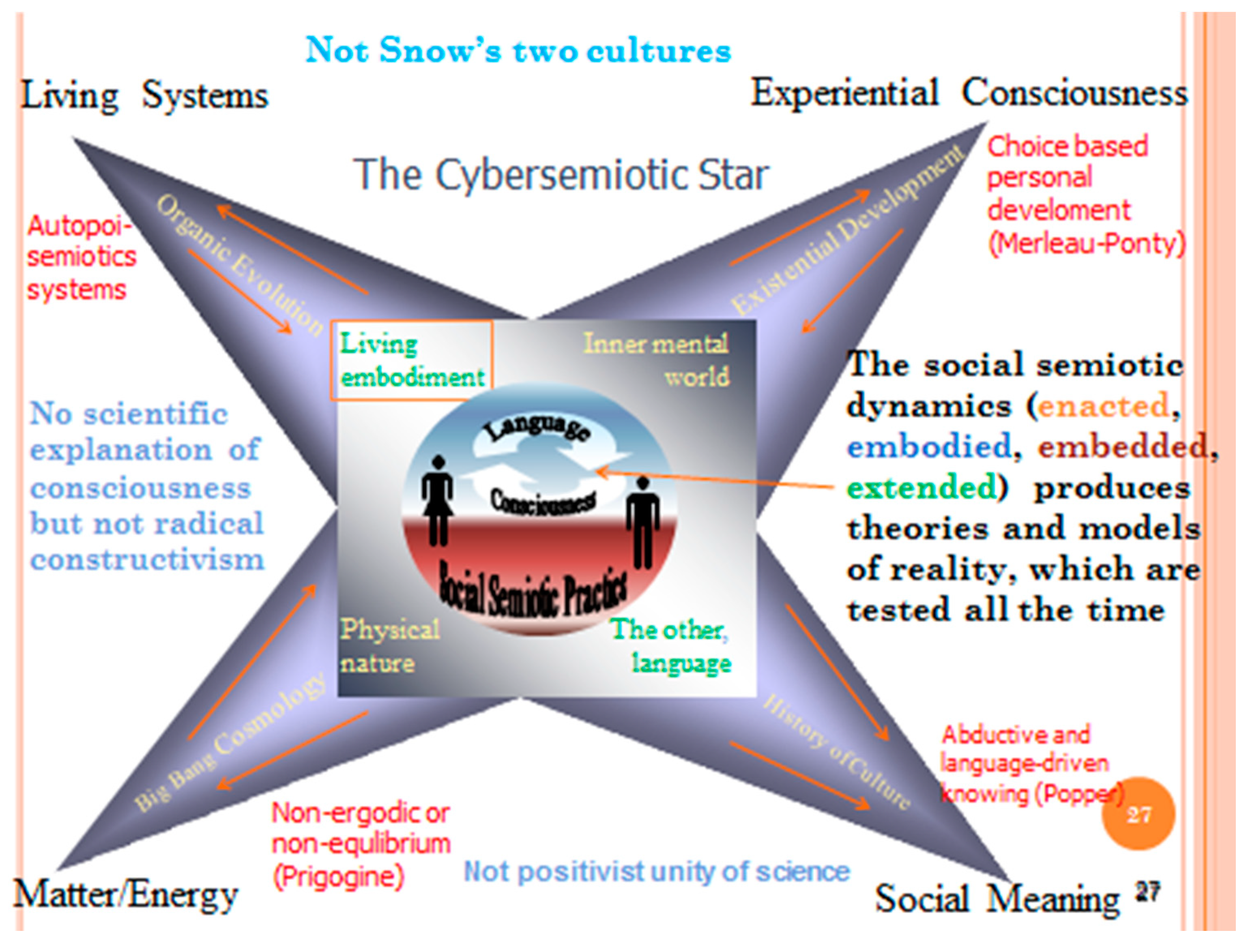Can Cybersemiotics Solve the Problem of Informational Transdisciplinarity? †
Abstract
:1. Introduction
2. Transdisciplinary Paradigms
Conflicts of Interest
References
- Dodig-Crnkovic, G. The info-computational nature of morphological computing. Philos. Theory Artif. Intell. 2013, 5, 59–68. [Google Scholar]
- Chaitin, G. Epistemology as information theory: From Leibniz to Ω. Collapse 2006, 1, 27–51. [Google Scholar]
- Luhmann, N. Social Systems; Stanford University Press: Stanford, CA, USA, 1995. [Google Scholar]
- Peirce, C.S. Collected Papers of Charles Sanders Peirce; Hartshorne, C., Weiss, P., Eds.; Harvard University Press: Cambridge, MA, USA, Past Masters electronic version containing Vols. I-VI ed. Charles Hartshorne and Paul Weiss (Cambridge, MA: Harvard University Press, 1931–1935), Vols. VII-VIII ed. Arthur W. Burks (same publisher, 1958).
- Kauffman, S. From physics to semiotics. In Gatherings in Biosemiotics; Silver, R.S., Bennett, T., Eds.; Tartu University Press: Tartu, Estonia, 2012. [Google Scholar]
- Kim, J. Mind in a Physical World: An Essay on the Mind-Body Problem and Mental Causation; The MIT Press: Cambridge, MA, USA, 1998. [Google Scholar]
- Brier, S. Cybersemiotics: Why Information is not Enough; Toronto University Press: Toronto, ON, Canada, 2008. [Google Scholar]
- Brier, S. Finding an information concept suited for a universal theory of information. Prog. Biophys. Mol. Biol. 2015, 119, 622–633. [Google Scholar] [CrossRef] [PubMed]
- Smolin, L. Time Reborn: From the Crisis in Physics to the Future of the Universe; Mariner Books: London, UK, 2014. [Google Scholar]
- Wheeler, J.A. At Home in the Universe; American Institute of Physics Press: New York, NY, USA, 1994. [Google Scholar]

Publisher’s Note: MDPI stays neutral with regard to jurisdictional claims in published maps and institutional affiliations. |
© 2017 by the author. Licensee MDPI, Basel, Switzerland. This article is an open access article distributed under the terms and conditions of the Creative Commons Attribution (CC BY) license (https://creativecommons.org/licenses/by/4.0/).
Share and Cite
Brier, S. Can Cybersemiotics Solve the Problem of Informational Transdisciplinarity? Proceedings 2017, 1, 196. https://doi.org/10.3390/IS4SI-2017-04105
Brier S. Can Cybersemiotics Solve the Problem of Informational Transdisciplinarity? Proceedings. 2017; 1(3):196. https://doi.org/10.3390/IS4SI-2017-04105
Chicago/Turabian StyleBrier, Søren. 2017. "Can Cybersemiotics Solve the Problem of Informational Transdisciplinarity?" Proceedings 1, no. 3: 196. https://doi.org/10.3390/IS4SI-2017-04105
APA StyleBrier, S. (2017). Can Cybersemiotics Solve the Problem of Informational Transdisciplinarity? Proceedings, 1(3), 196. https://doi.org/10.3390/IS4SI-2017-04105




